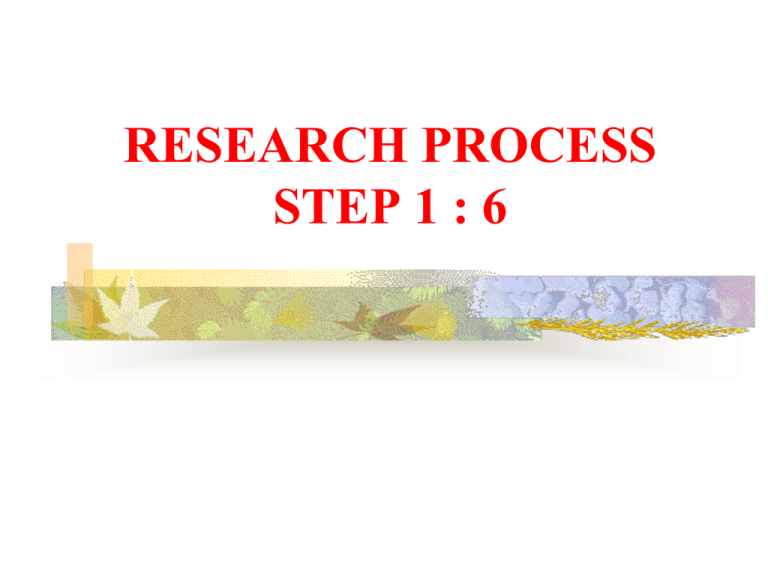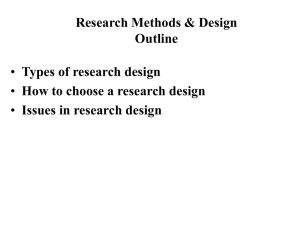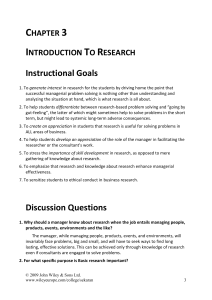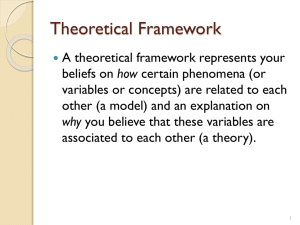RESEARCH METHODS FOR BUSINES
advertisement

RESEARCH PROCESS STEP 1 : 6 THE RESEARCH PROCESS Steps 1 to 3 : 1. Observation-Broad Problem Area 2. Preliminary Data Gathering 3. Problem Definition/Research Questions Clarifying the Research Question Management-research question hierarchy process begins by identifying the management dilemma OBSERVATION : BROAD PROBLEM AREA BROAD PROBLEM AREA Problem Currently Existing Situation Requiring Improvement A Conceptual or Theoretical Issue that Needs to be Tightened Up Some Research Questions that a Basic Researcher Wants to Answer Empirically PRELIMINARY DATA COLLECTION PRELIMINARY DATA COLLECTION Nature of Data To Be Gathered : 1. Background Info of the Organization-that is, the Contextual Factors 2. Managerial Philosophy, Company Policies, and other Structural Aspects 3. Perception, Attitudes, and Behavioral Responses of Organization Members and Client Systems (as applicable) BACKGROUN INFO OF THE ORGANIZATION The Origin and History of the Company Size in term of Employees, Assets, etc Charter– Purpose and Ideology Location—Regional, National, or Other Resources– Human and Others Interdependent Relationships with Other Institution and the External Environment Financial Position during the Previous 5 to 10 years, and Relevant Financial Data INFORMATION ON MANAGEMENT PHILOSOPHY AND STRUCTURAL FACTORS STRUCTURAL ASPECTS Roles and Position in the Organization and Number of Employees at each Job Level Extent of Specialization Communication Channels Control Systems Coordination and Span of Control Rewards Systems Workflow Systems and the like PERCEPTIONS, ATTITUDES, AND BEHAVIORAL RESPONSES Attitudinal Factors Comprise People’s Beliefs About and Reaction to the Following: 1. Nature of Work 2. Workflow Interdependencies 3. Superiors in the Organization 4. Participation in Decision Making 5. Client Systems 6. Co-workers 7. Reward Provide by the Organization Attitudinal,……………… 8. 9. 10. 11. Opportunities for Advancement in the Organization Organization Attitudes toward Employees’ Family Responsibilities Company Involvement with Community Company Tolerance of Employees’ Taking time off from the Job Behavioral Factors: Include the following: Work habit such as industriousness, extent of absenteeism, performance on the job, etc. LITERATURE SURVEY A Good Literature Survey Ensures : • Important Variables are not left-out • A clear Idea Emerges • Problem Statement can be made with Precision and Clarity • Testability and Replicability are Enhanced • No need to “ Reinvent the Wheel” • The Problem investigated is Perceived as Relevant and Significant by Scientific Community PROBLEM DEFINITION OR PROBLEM STATEMENT A Problem Defined as: Any Situation Where a Gap Exists Between the Actual and the Desired Ideal States Symptoms of Problem VS Real Problem Antecedent, Real Problem, or Consequence ? Clarifying the Research Question Management-research question hierarchy process begins by identifying the management dilemma Research Process Problems to Avoid •Ill-defined management problem •Unresearchable questions •Politically-motivated research RESEARCH STEP 4 THEORITICAL FRAMEWORK DEFINITION Concept : - is the basic building blocks of scientific investigation. They are creations of the human mind that are used in the classification and communication of the essence of some set of observations. Concept can be defined as abstract ideas generalized from particular facts DEFINITION Construct : Is specific types of concepts that exist at higher levels of abstraction and are invented for some special theoretical purpose. Generally, construct is not directly tied to observation. Instead, they are inferred by some indirect method, such as paper and pencil questionnaires DEFINITION Theory : Is a set of interrelated constructs (concepts), definitions, and propositions that present a systematic view of phenomena by specifying relations among variables, with the purpose of explaining and predicting the phenomena THEORITICAL FRAMEWORK Topic Discussed : The Need for Theoretical Framework Type of Variables Theoretical Framework and Its Five Basic Features The Need For A Theoretical Framework A Theoretical Framework is a Conceptual Model of how one Theorizes or Makes Logical Sense of the Relationships among the Several factors that have been Identified as Important to the Problem Type of Variables Dependent Variable Independent Variable Moderating Variable Intervening Variable Dependent Variable Is the Variable of Primary interest to the Researcher The Researcher’s goal is to understand and describe the Dependent Variable, or to explain its variability, or to predict it Independent Variable Is One that Influences the dependent variable in either a positive or a negative way New Product Success IV Managerial Values IV Number of Books IV Stock Market Price DV Power Distance DV Reading Abilities DV Moderating Variable Is one that has a strong Contingent effect on the Independent variable– dependent variable relationship. That is , the presence of a third variable ( the moderating variable) modifies the original relationship between the independent variable and the independent variable. Reading Abilities Number of Books DV IV Parents’ literacy MV Organizational effectiveness Workforce diversity DV IV Managerial expertise MV Copyright © 2003 John Wiley & Sons, Inc. Sekaran/RESEARCH 4E FIGURE 5.5a Copyright © 2003 John Wiley & Sons, Inc. Sekaran/RESEARCH 4E FIGURE 5.5b Intervening Variable In one that surfaces between the time the independent variables operate to influence the dependent variable and their impact on the dependent variable Copyright © 2003 John Wiley & Sons, Inc. Sekaran/RESEARCH 4E FIGURE 5.6 Copyright © 2003 John Wiley & Sons, Inc. Sekaran/RESEARCH 4E FIGURE 5.7 Copyright © 2003 John Wiley & Sons, Inc. Sekaran/RESEARCH 4E FIGURE 5.8 Copyright © 2003 John Wiley & Sons, Inc. Sekaran/RESEARCH 4E FIGURE 5.9 Copyright © 2003 John Wiley & Sons, Inc. Sekaran/RESEARCH 4E FIGURE 5.10 Copyright © 2003 John Wiley & Sons, Inc. Sekaran/RESEARCH 4E FIGURE 5.11 Copyright © 2003 John Wiley & Sons, Inc. Sekaran/RESEARCH 4E THEORETICAL FRAMEWORK ANSWERS TO EXERCISES (PAGES 113-120 OF MANUAL) 5D Copyright © 2003 John Wiley & Sons, Inc. Sekaran/RESEARCH 4E THEORETICAL FRAMEWORK ANSWERS TO EXERCISES (PAGES 113-120 OF MANUAL) 5E Copyright © 2003 John Wiley & Sons, Inc. Sekaran/RESEARCH 4E THEORETICAL FRAMEWORK ANSWERS TO EXERCISES (PAGES 113-120 OF MANUAL) 5F Copyright © 2003 John Wiley & Sons, Inc. Sekaran/RESEARCH 4E THEORETICAL FRAMEWORK ANSWERS TO EXERCISES (PAGES 113-120 OF MANUAL) 5H Copyright © 2003 John Wiley & Sons, Inc. Sekaran/RESEARCH 4E THEORETICAL FRAMEWORK ANSWERS TO EXERCISES (PAGES 113-120 OF MANUAL) 5J Copyright © 2003 John Wiley & Sons, Inc. Sekaran/RESEARCH 4E THEORETICAL FRAMEWORK ANSWERS TO EXERCISES (PAGES 113-120 OF MANUAL) 5K THEORITICAL FRAMEWORK FIVE BASIC FEATURES OF THEORITICAL FRAMEWORK 1. 2. The variables considered relevant to the study should be clearly identified and labeled in the discussion The discussion should state how two or more variables are related to one another. This should be done for the important relationships that are theorized to exist among the variables FIVE BASIC………. 3. 4. If the nature and direction of the relationships can be theorized on the basis of the findings from previous research, then there should be an indication in the discussions as to whether the relationships would be positive or negative There should be a clear explanation of why we would expect these relationships to exist. The arguments could be drawn from the previous research finding FIVE BASIC…….. 5. A schematic diagram of the theoretical framework should be given so that the reader can see and easily comprehend the theorized relationships STEP 5: HYPOTHESES DEVELOPMENT DEFINITION Proposition : A statement about concepts that may be judged as true or false if it refers to observable phenomena When proposition is formulated for empirical testing, we call it a Hypothesis DEFENITION OF HYPOTESIS A hypothesis can be defined as a logical conjectured relationship between two or more variables expressed in the form of a testable statement. HYPOTHESES Formats (If-Then Statement or Propositions) Directional and Nondirectional Hypotheses Null and Alternate Hypotheses HYPOTHESES : FORMATS Proposition Example : employees who are more healthy will takes sick leave less frequently If-then If employee are more healthy, then they will take leave less frequently Non-Directional Hypotheses There is a relationship between age and job satisfaction There is a difference between the work ethic values of American and Asian Directional Hypotheses The greater the stress experienced in the job, the lower the job satisfaction of employees Women are more motivated than men Null and Alternate Hypotheses For Group Differences : Null Hypotheses : H0 : μM = μW or H0 : μM – μW = 0 Alternate Hypotheses: HA : μM < μW ( Directional) or HA : μW > μM Alternate Hypotheses: HA : μM ≠ μW ( Nondirectional) For the Relation Between Two Variables Null Hypotheses: H0 : ρ = 0 Alternate Hypotheses: HA: ρ < 0 (Directional) HA: ρ ≠ 0 (Nondirectional)





